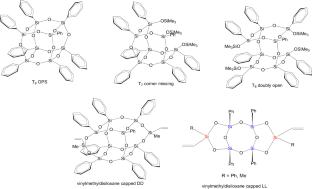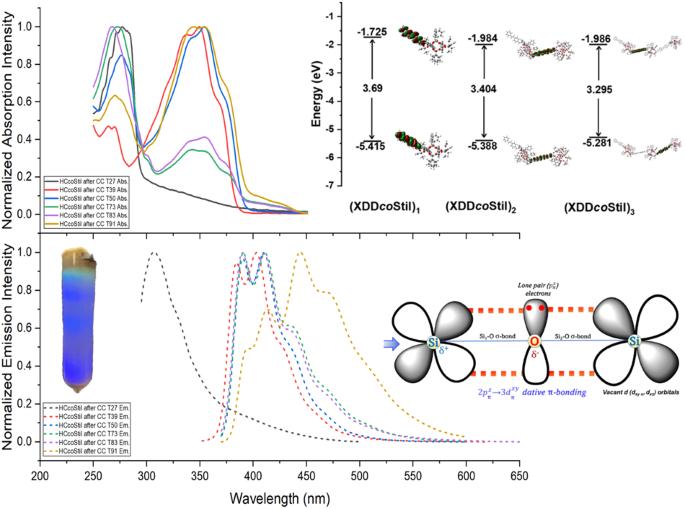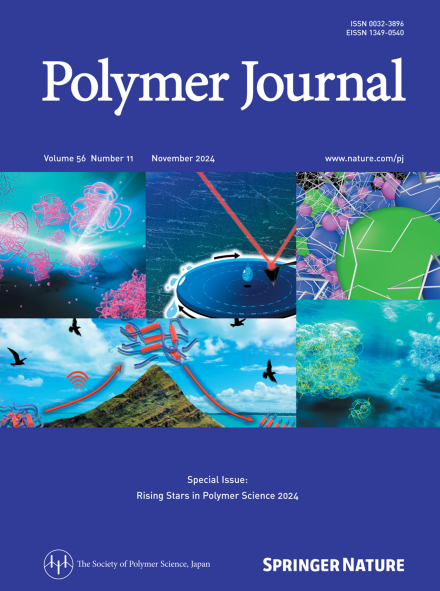通过意外的 Si-O-Si dπ-pπ 重叠实现聚硅氧烷共聚物中的共轭,这是第二种机制?
IF 2.3
4区 化学
Q3 POLYMER SCIENCE
引用次数: 0
摘要
摘要我们以前曾报道过,功能化的苯基和乙烯基硅倍半氧烷(SQs)和[RSiO1.5]8,10,12(R = Ph 或乙烯基)表现出红移吸收和发射,表明它们通过笼心最低未占分子轨道(LUMO)进行三维共轭。缺角的官能化 [PhSiO1.5]7(OSiMe3)3 和边缘开放、末端封端的 [PhSiO1.5]8(OSiMe2)2 (双层,DD)类似物也显示出发射红移,表明存在三维共轭。DD[PhSiO1.5]8(OSiMe2)2和R-Ar-Br共聚物显示出聚合(DP)依赖性发射λmax和2,3,5,6-四氟-7,7,8,8-四氰基二甲烷(F4TNCQ)的整数电荷转移(ICT)。三元共聚物平均红移均表明,可能通过笼心 LUMO,共轭了两个(O-Si-O)端盖。在评估共轭极限时,预计阶梯(LL)SQ (vinylMeSiO2)[PhSiO1.5]4(O2SiMevinyl) 与 Br-Ar-Br 的共聚物和无笼型共聚物将消除 LUMO 的形成和红移。在类似的共聚物中观察到的λmax 值更大,这需要不同的解释。在这里,我们评估了更接近聚硅氧烷的共聚物的光物理行为,即膨胀笼 (MeVinylSiO)2[PhSiO1.5]8(OSiMeVinyl)2SQs 。Br-Ar-Br共聚物表现出红移吸收和红移发射,这支持了通过Si-O-Si键而不是笼心LUMO的共轭,这与Si-O-Si共聚物的传统观点相反。单光子和双光子光物理探针显示,XDD 共聚物显示出多种荧光发射激发态,这违反了卡沙规则,即只有最低激发态才会发生发射。最后,新的建模研究表明,共轭作用源于 Si-O-Si 键 dπ-pπ 相互作用,这对于支持两种共轭形式的聚硅氧烷来说是一个意想不到的结果。本文章由计算机程序翻译,如有差异,请以英文原文为准。


Conjugation in polysiloxane copolymers via unexpected Si-O-Si dπ-pπ overlap, a second mechanism?
We previously reported that functionalized phenyl- and vinyl-silsesquioxanes (SQs) and [RSiO1.5]8,10,12 (R = Ph or vinyl) exhibited redshifted absorption and emission, suggesting 3-D conjugation via a cage-centered lowest unoccupied molecular orbital (LUMO). The functionalized [PhSiO1.5]7(OSiMe3)3 with a missing corner and edge-opened, end-capped [PhSiO1.5]8(OSiMe2)2 (double decker, DD) analogs also exhibit emission redshifts, indicating 3-D conjugation. DD [PhSiO1.5]8(OSiMevinyl)2 and R-Ar-Br copolymers exhibit polymerization (DP)-dependent emission λmax and integer charge transfer (ICT) to 2,3,5,6-tetrafluoro-7,7,8,8-tetracyanoquinodimethane (F4TNCQ). The terpolymer-averaged redshifts all suggest conjugation with two (O-Si-O) endcaps, possibly via a cage-centered LUMO. In assessing conjugation limits, it was anticipated that copolymers of the ladder (LL) SQ, (vinylMeSiO2)[PhSiO1.5]4(O2SiMevinyl), with Br-Ar-Br and without a cage would eliminate LUMO formation and a redshift. The λmax values observed were greater for analogous copolymers, which requires a different explanation. Here, we assess the photophysical behavior of copolymers closer to polysiloxanes, namely, the expanded cage (MeVinylSiO)2[PhSiO1.5]8(OSiMeVinyl)2SQs. Copolymers with Br-Ar-Br exhibit redshifted absorption and emission, which supports conjugation via Si-O-Si bonds rather than cage-centered LUMOs, contrary to traditional views of Si-O-Si copolymers. One- and two-photon photophysical probes showed that XDD copolymers exhibit multiple fluorescence-emitting excited states, in violation of Kasha’s rule stating that emission should occur only from the lowest excited state. Finally, new modeling studies suggested that conjugation derives from Si-O-Si bond dπ-pπ interactions, an unexpected result for polysiloxanes that supports two forms of conjugation. a Column separation under black light illumination. b Calculated overlap of dπ-pπ orbitals demonstrating conjugation
求助全文
通过发布文献求助,成功后即可免费获取论文全文。
去求助
来源期刊

Polymer Journal
化学-高分子科学
CiteScore
5.60
自引率
7.10%
发文量
131
审稿时长
2.5 months
期刊介绍:
Polymer Journal promotes research from all aspects of polymer science from anywhere in the world and aims to provide an integrated platform for scientific communication that assists the advancement of polymer science and related fields. The journal publishes Original Articles, Notes, Short Communications and Reviews.
Subject areas and topics of particular interest within the journal''s scope include, but are not limited to, those listed below:
Polymer synthesis and reactions
Polymer structures
Physical properties of polymers
Polymer surface and interfaces
Functional polymers
Supramolecular polymers
Self-assembled materials
Biopolymers and bio-related polymer materials
Polymer engineering.
 求助内容:
求助内容: 应助结果提醒方式:
应助结果提醒方式:


